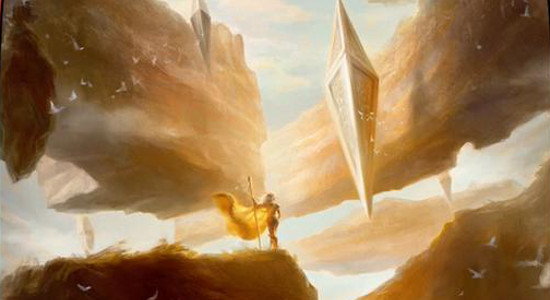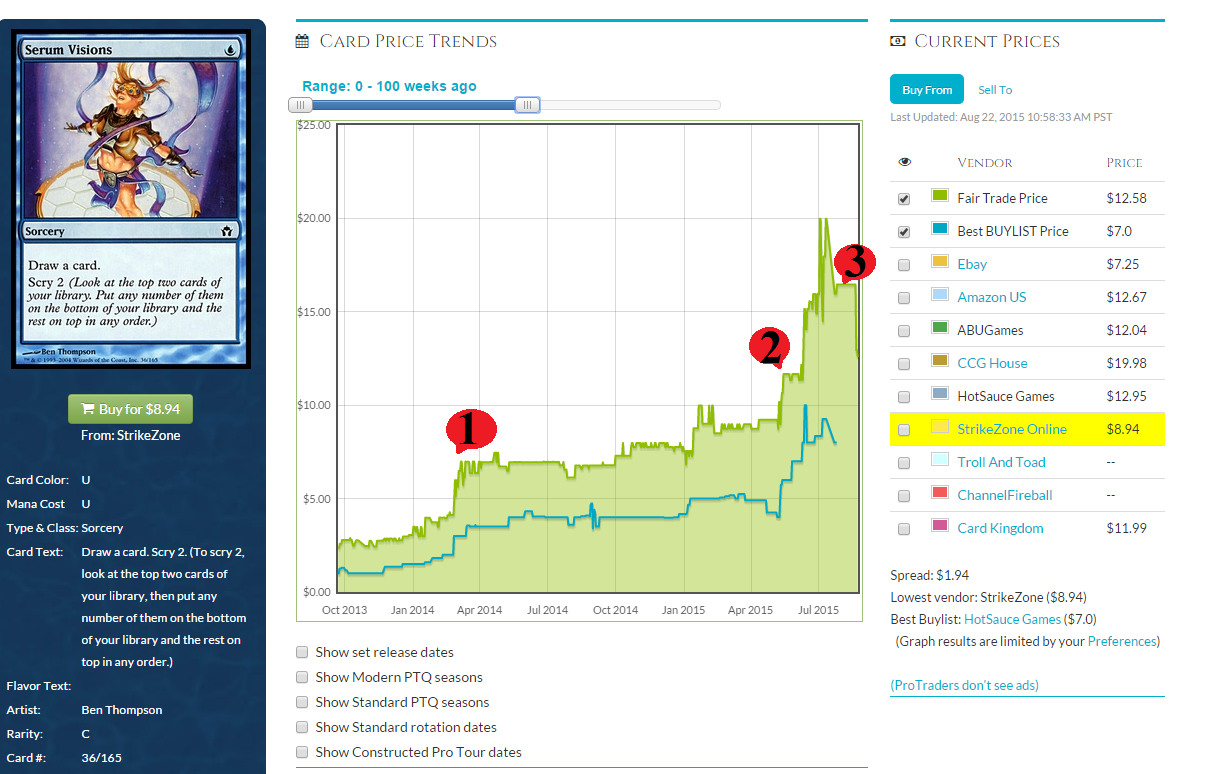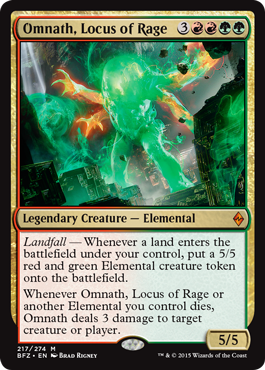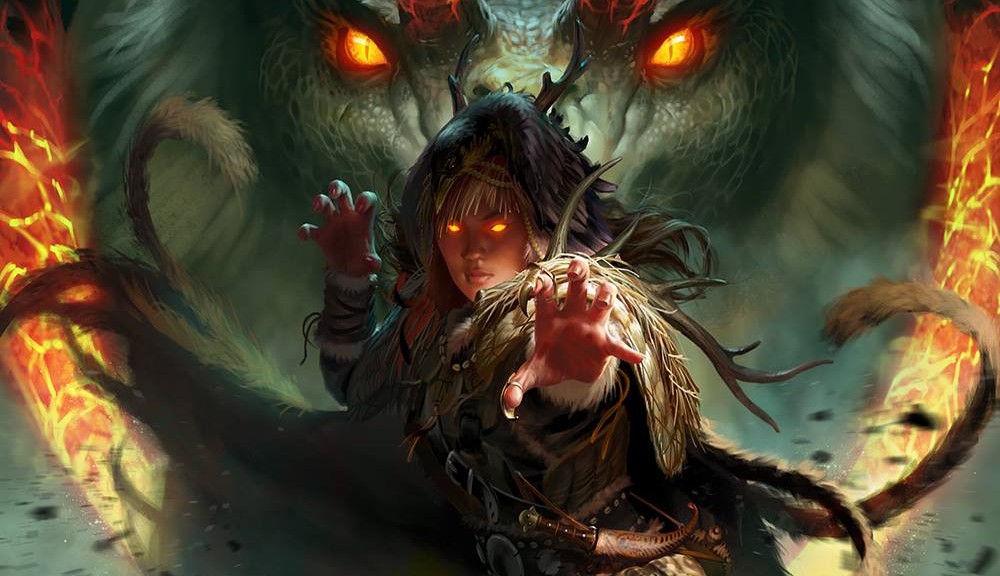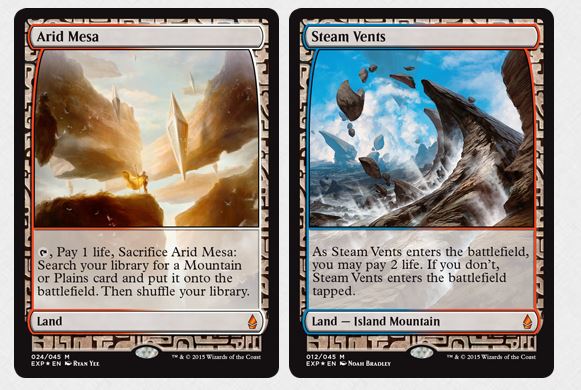By: Derek Madlem
In case you missed it, Wizards broke the internet on Saturday night with their PAX preview party for the upcoming set Battle for Zendikar. The stream was pretty abysmal thanks mostly to the inclusion of Wil Wheaton making butthole jokes and telling us that the Eldrazi were the good guys… and that every single card was “AWESOME” even if it was probably closer to mediocre at best. They unveiled a lot of sweet things that I’m stoked to talk about in the coming weeks, but they also decided now was the time to jump the shark:
In Battle for Zendikar we’ll have a subset of full art FOIL lands encompassing ten fetch lands, ten shock lands, and five of Zendikar’s new dual land… and they look AWESOME. They’re being referred to as Expedition lands and I want a playset of each… but I’m not exactly ready to sell off my Power 9 to acquire them. Did I mention they’re going to be rare? No, rarer than that.
In the stream they were described as being about the same rarity as a Mythic FOIL rare but a little more common because there are 25 of them vs. 15 Mythics. While we’ve yet to see exactly what that means in terms of actual rarity, there is roughly one FOIL Mythic rare in every 216 packs of Magic, so let’s use that as our starting point. For reference: there are 216 packs (36×6) in a case of Magic!
Parameters
So what are these going to be worth? It’s a safe bet to assume that all of these are going to be worth more than their regular FOIL counterparts, even if they do have a questionable hedron-laden frame.
Here’s what current incarnations of these cards look like financially:
Zendikar FOIL Scalding Tarn – $180
Khans of Tarkir FOIL Polluted Delta – $90
Return to Ravnica FOIL Steam Vents – $45
So what kind of premium do we place on the new hotness? The fetchlands are likely to hold a higher premium than the shocklands because of their inclusion in Vintage and Legacy, two formats where players are no strangers to “pimping”.
It’s no stretch pricing the full art Scalding Tarn in the $250+ range and I can see that anchor point pulling all of the other fetches up to the same price range with the blues easily settling in the $200-250 range and tapering down from there to Marsh Flats at $150 or so.
The shock lands are easily going to top out with Steam Vents and Watery Grave in the $100-125 range and the rest spanning the $75-100 range.
The new duals will bring up the rear with a likely top end in the $50 range based almost entirely on rarity as I don’t expect these cards to have much impact outside of Standard; there’s just too few scenarios where these are better in Modern than a shock land and they are unplayable in Legacy and Vintage.
This is the point where I insert a disclaimer stating that all of these estimates are probably on the conservative end of the spectrum, and that some of these (looking at you Scalding Tarn) could hit obscene numbers initially.
So that’s pretty awesome right? Even the disappointment of opening a tango land because it could have been a fetchland won’t feel that bad…a free fifty bucks is nothing to sneeze at! But what impact will these cards have on the financial market as a whole?
Aggregate Pricing
For retailers, the bulk of the initial singles supply comes from opening boxes. Typically when you look at a new set, you’ll see that the preorder prices typically create an EV (expected value) per pack that exceeds the price of a pack. As time goes on and more and more singles flood the market, the value of a pack fast approaches an equilibrium where the singles contained within a box become roughly in sync with the price of a box…then MTGO redemptions hit the market and that price implodes as additional cards enter the market.
The effect this has on the secondary market is very noticeable once you know what to look for. Let’s take Khans of Tarkir as an example, because some of the singles prices are almost criminally low. Khans featured the five card cycle of fetch lands that we’ve all grown to love and everybody JUST HAS TO HAVE. Because those fetch lands took up so much of the EV equity, many other cards plummeted in price. As retailers and players alike shredded packs to acquire fetch lands, they were left with piles of Sarkhan Dragonspeaker, Siege Rhino, Wingmate Roc, and other competitive level rares…but they were only selling the fetch lands and were stuck with piles of these other cards – until they lowered the price.
The contents of an in-print Magic booster box can only be worth so much money. What’s this have to do with the Expedition lands? If the Expeditions lands average out to $120ish each and show up one per case, that’s essentially soaking up $20 in EV equity from every box, which will push prices of every rare in the set downward. Combine this with 50¢ a piece on full-art basics and you’re easily looking at $35+ EV equity being carved out of every box.
Earnings Expectations
Wizards of the Coast is a division of Hasbro, the company that derives much of it’s income from Transformers and and licensed action figures from intellectual properties like Spiderman or The Avengers. The licenses for much of the Marvel product lines can evaporate on a whim from Disney so Hasbro has a lot of it’s eggs in the Transformers basket, an intellectual property that has relied on half hour commercials (cartoons) and blockbuster movies to boost sales. With no Transformers movie on the horizon until 2017, Hasbro is looking elsewhere to make up that lost revenue…lucky for them, Magic has been experiencing year over year growth for the last seven or eight years.
For the most part, Hasbro stays “hands off” as far as Magic goes, relying on the people that have made the game a success to continue making it a success…but you can bet that Magic continuing year over year growth is an expectation that is on the table.
Last year Wizards sold more packs of cards than ever, thanks heavily to the fetch lands and partly thanks to a pile of dragons. This is awesome, a growing game is great for everyone involved right? But some growth is not growth…what do I mean? Let’s look at an example:
For the first year let’s say there are 10 total Magic players and they buy 10 packs each.
Magic sells 100 packs.
Which scenario the following year is better for the game long term:
15 total Magic players buying 10 packs each?
OR
10 total Magic players buying 15 packs each?
If you guessed 15 players buying 10 packs each, you and I are in the same boat.
So this year Wizards is staring down an expectation to beat last year’s sales, they’re already returning us to one of the most beloved planes to face down some of the most revered villains in Magic’s history and that should be enough, but what if it’s not? Enter Expedition lands. These are all but guaranteed to sell more product and Wizards is likely to experience another year of continued sales growth. But what happens next year?
Another gimmick? FOIL full-art Planeswalkers? Tarmogoyfs and Vendilion Cliques? Rishadan Ports and Wastelands? Wizards is painting themselves into a corner with the expectation of super ultra rare promos in future sets. If the sets after Zendikar and its expansion don’t contain this type of promotion will the players feel shorted? How much will that affect sales?
Seriously, how do they match this level of awesome in a future set without resorting to an escalation of gimmicks? Where does this road lead us?
Sports card collectors will tell you that they’ve been down this road before. The sports card industry underwent an escalation of absurdity when it came to chase cards and as collectors cracked open cases to find these ultra-rare chase cards, the rest of the contents (that would have traditionally been worth money) became near-worthless.
Why Now?
Why now? Seriously, why is Wizards resorting to gimmickry now? Since Wizards doesn’t release print run or player base numbers to the public anymore we can’t be sure what exactly Magic’s growth looks like. Did the Magic player base grow 2% last year but sales increased 4%? That’s important information to know.
My biggest concern going forward is where the growth is coming from, if we’re reaching a plateau in playerbase growth and Wizards is pushing out super ultra chase rares to increase revenue in a different manner, that will have a significant impact on the secondary market long term. Cards rotating out of Standard will take longer to rebound in price, or they might stop rebounding at all.
For a card to appreciate once it’s rotated out of Standard and into Modern, the demand for a card in non-rotating formats has to grow…something that won’t happen if supply greatly exceeds demand.
Miscellaneous Concerns
Another side effect of the Expedition lands is the shift from buying boxes to buying cases of product. I’m already locking myself in to either buy a case of Battle for Zendikar or none at all…missing the box that contained the Expedition land would be an absolute blowout when it comes to getting a return on your initial investment. Along this same vein is the reality that loose boxes will partly become “damaged goods” as retailers can just start opening packs until they hit the Expedition land and then put the rest of those boxes on the shelf to sell individually or as single packs. Sure those other boxes “could” have an Expedition land in them, but it’s going to be less likely given Wizards’ collation methods.
The impact on local game stores is also something to consider. Nobody opens a game store to sell packs of Magic, it takes far too many boosters sold to pay the rent; the real money is in singles. But what if the bulk of those singles aren’t worth anything anymore? Many retailers will tell you that their bread and butter is selling cards ranging from $5-20 because the margins are always good and the profits add up quickly. If the average rare in a set is worth 20% less because of super ultra chase rares, that’s going to have an impact on their bottom line. Sure, they can sell the super ultra chase rares as well…but almost anyone will tell you that they would rather have ten $20 cards to sell than one $200 card because expensive cards just sell slower.
Silver Lining
In a sense, the Expedition lands could have a very nice socialist redistribution of wealth effect on the secondary market. If so much of the EV equity is being soaked up by these super ultra chase cards, the price of most of the other cards should go down, essentially creating a situation where the people that have the money to shell out for these stupidly rare cards are subsidizing the price of singles for players that can’t afford them at all. This means that maintaining a competitive Standard deck will likely get a little easier…for the next two sets, then we’ll see where Wizards goes from there.
In Conclusion
I love these lands and very much want to own a playset of the shocks and fetches but know that despite my Magic budget and resources being well above average, that’s not even a fathomable reality for me. I couldn’t even begin to consider shelling out the $12,000 or so it would take to complete a playset of these cards. I’ve grown accustomed to not having everything thanks heavily to the From the Vault and San Diego Comic Con products, so I can live without.
I’m not against the idea of these cards existing, I’m against the level of unattainability that they’re being offered to us and concerned what this means for future Magic releases. Is it only a matter of time before we see these promo subsets with every release? What’s this mean for the secondary market as whole? These are real questions that we have to consider if we’re to continue playing the #mtgfinance game in the coming years.
Shameless self promotion: I’ll be working with Hotsauce Games at the SCG Open in Cincinnati this weekend, stop by and see us!


